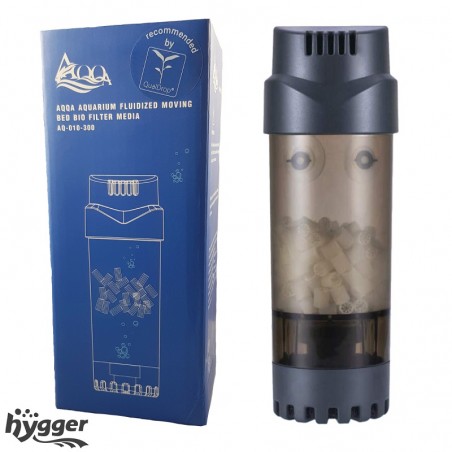







How it works and why is it a brilliant solution ...
The Hygger moving bed biofilter works on the principle of fluidization.
Fluidization is the process of creating a dynamic suspension, the so-called fluidized bed .
The fluidized bed consists of solid particles, in this case a filter bed, moving in a stream of air and water from bottom to top.
Fluidization intensifies physical and chemical processes.
The phenomenon of fluidization is used in the Hygger biofilter .

Security policy

Delivery policy

Return policy
The volume of the bed in the Hygger biofilter is approx. 50% of the total filter capacity.
The bed has a special structure and a density similar to,
but lower than that of water (water density is about 1 g / cm3, and the bed density is about 0.94-0.97 g / cm3).
This value allows it to float freely in the water column and circulate inside the filter from bottom to top under the influence of the supplied fine air bubbles.
The Hygger biofilter contains a filter bed with a large specific surface on which nitrifying bacteria grow.
The bed provides the maximum surface area for the growth of these beneficial bacteria,
supporting the nitrification cycle.
Nitrification is an aerobic process and requires the presence of oxygen to proceed.
Very intensive aeration significantly increases the oxygen saturation inside the filter and thus intensifies the nitrification process.
Bacteria of the Nitrosomonas and Nitrobacter genus take part in the nitrification process,
which in turn "convert" "ammonia" - NH 4 to nitrite NO 2 ,
and then to the least harmful NO 3 nitrates, which are used in the tank, among others. through the plants.
In fact, the mechanism of the nitrification process is more complex and depends on many factors.
How to properly start the biofilter
The biofilter is designed for tanks with a capacity of 30 l to 150 l .
The biofilter should be treated as a supplement to the filtration in the tank based on, for example, a biochemical sponge-ceramic filter from Hygger .
1. Before the first use, rinse the filter preferably in RO water or
in water from a tank.
2. Attach the four suction cups, press them down.
3. Connect the tube to the filter with air supply. The filter is ready for use.
4. Place the filter in the tank. Attention! When the filter is started for the first time,
the smooth movement of the bed begins after a few or several hours. Patience ...
ATTENTION!
The filter must be connected to an appropriately sized air pump.
Recommended pump power is 5W .
Be sure to include a check valve on the air supply tubing to prevent backflow of water during a power outage.
The filter sponge in the bottom filter cover has a density of approximately 40-45 ppi.
It is safe for small and newborn shrimps.
Requires regular cleaning every 1-2 weeks.
You might also like